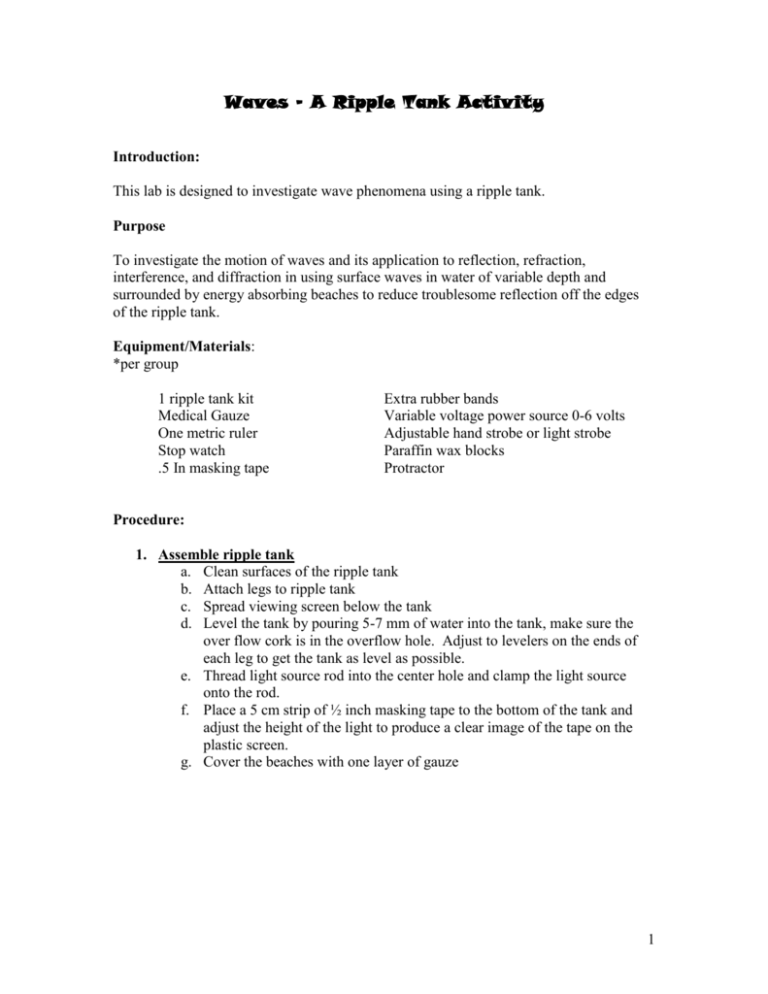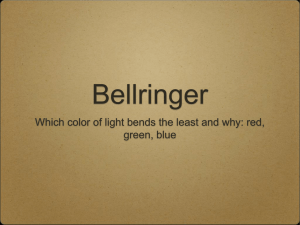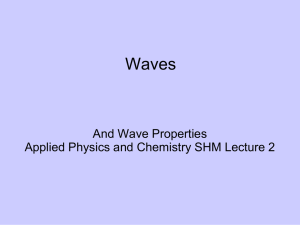Ripple Tank
advertisement

Waves – A Ripple Tank Activity Introduction: This lab is designed to investigate wave phenomena using a ripple tank. Purpose To investigate the motion of waves and its application to reflection, refraction, interference, and diffraction in using surface waves in water of variable depth and surrounded by energy absorbing beaches to reduce troublesome reflection off the edges of the ripple tank. Equipment/Materials: *per group 1 ripple tank kit Medical Gauze One metric ruler Stop watch .5 In masking tape Extra rubber bands Variable voltage power source 0-6 volts Adjustable hand strobe or light strobe Paraffin wax blocks Protractor Procedure: 1. Assemble ripple tank a. Clean surfaces of the ripple tank b. Attach legs to ripple tank c. Spread viewing screen below the tank d. Level the tank by pouring 5-7 mm of water into the tank, make sure the over flow cork is in the overflow hole. Adjust to levelers on the ends of each leg to get the tank as level as possible. e. Thread light source rod into the center hole and clamp the light source onto the rod. f. Place a 5 cm strip of ½ inch masking tape to the bottom of the tank and adjust the height of the light to produce a clear image of the tape on the plastic screen. g. Cover the beaches with one layer of gauze 1 2. Pulses a. Procedure: Lightly touch the surface of the water near the middle of the ripple tank. Study the wave you’ve created. Notice that the wave front is circular and travels outward with a constant speed from the point where your finger touched the water. Question: Does the speed of the pulse depend at all on how quickly your finger touched the water? Measure the distance from the spot on the viewing screen where you touch the water to edge of the screen. Time how long it takes for the pulse to get from the contact point to the edge. Determine the speed of the pulse from the screen. Repeat touching the water faster and slower and determine the speed for each. Does it change appreciably? b. Procedure: Place the dowel in the water and move it (roll it) forward a small amount. Notice the shape of the wave front. This time you should see a straight wave (or plane wave) travel across the tank. Question: Is the speed of this wave front the same as the circular wave? Question: How could you find out? Answer: Measure the distance from the dowel to the edge of the tank and measure how long it takes the wave travel that distance. Determine the speed of the wave. You should find out that the waves move at the same speed. Question! Will the speed of the waves change if you push on the dowel rather than pull on the dowel to create a disturbance? Discovery: Determine this as we did above. 3. Reflections a. Procedure: Reflection from a point source: Place a flat obstruction, paraffin wax or wood is fine, near the middle of the tank. Make a wave pulse by dipping your finger into the water. Observation: What happens as the wave strikes the barrier? Observation: What does the reflected wave look like? Question: why do you think the wave looks like this? b. Procedure: Reflection from line force: Use a dowel or any long object to create a line wave. First position the barrier so that the waves run parallel to it. Observation: What does the reflected wave look like? Procedure: Position the barrier so that the waves hit the barrier at a different angle. Place a pencil on the screen so that it is perpendicular to the shadow from the barrier. Observation: Is the angle created by the incoming wave similar or even identical to the angle reflected off the barrier? 2 c. Procedure: Try replacing the straight barrier with a parabolic, curved barrier. Place the curved side toward the wave source. Create a line pulse. Observation: What is the shape of the reflected wave? Observation: Is there a spot in front of the curved mirror where the reflected wave meets? Answer: the answer is yes this is called the focal point and the distance from this point to the mirror is called the focal distance. Procedure: Repeat this, but change the angles at which the waves approach the parabolic reflector. Question: Did the focal length change or did the position of the focal point change. Answer: The answer should be no. Try creating a point source wave with the focal point as its origin. Observation: What does the reflected wave look like? Answer: The wave should be a line wave. Produce a point pulse inside the focal point. Observation: What does the wave look like now? Parabolic reflectors are used in a variety of places from reflecting telescopes that receive straight line waves and concentrate them on a point to flashlights that create a point source of light and spreads the light out. Even satellite TV antennas which gather radio waves from a satellite and concentrate it a receiver. 4. Traveling waves: All periodic waves can be described by this relationship Velocity = wavelength times frequency Substituting in v for the velocity of the wave, λ for wavelength of the wave, and υ for the frequency of the wave one gets v= λυ. This relationship can be investigated by using the ripple tank. To generate periodic waves set up the straight wave generator, connect the motor to a variable DC power source, and add water to a depth of abut 5 to 8 millimeters. Note you may have to adjust the generator with different length rubber bands so that the generator just comes in contact with the water. Determining Frequency: You can use the adjustable stroboscope, but at this time I am waiting for a variable speed strobe light to see how it works, for now practice using the stroboscope so that when viewing through the top portion of the stroboscope you can spin it so that you see a standing wave. Determine how many openings per second are produced when you spin the disc of the stroboscope when the standing wave is produced. At this time I have no easy way to do this and there was know explanation in the literature on producing a constant spin to produce this frequency. Thus we are ordering a strobe light. At which point I will experiment with the strobe and this section will be 3 amended. To continue! Let us say that the frequency at which a frozen wave is produced is at 10 slots per second or in the case of the strobe 10 flashes per second or a frequency of 10 Hertz. The frequency used should be the lowest frequency used to freeze the wave, because multiples of this frequency will also produce a frozen wave. This frequency will correspond to the frequency of the wave produced. Question can you explain why? Determining wavelength: Once you have visually frozen the wave with the stroboscope or strobe light, have your lab partner position two pencils or rulers on the screen below the ripple tank: The pencils being parallel to the waves and several wavelengths apart. To measure the wavelength you must measure the distances between the two pencils and divide by the number of waves between the pencils. This will give you the shadow wavelength. Then you must account for the difference in scale between the screen and the ripples in the tank. Place a 2 cm piece of masking tape, this should be measured and not estimated, under the ripple tray so that the length of the tape is perpendicular to the wave front. Measure the length of the shadow produced by the tape on the screen. From this ratio: Length of masking tape/ length of masking tape shadow = Actual wavelength / measured shadow wavelength one can determine the wavelength of the waves in the tank. Length of masking tape = Actual wavelength Measured shadow length Measured wavelength on the screen Calculate the speed using the Velocity = wavelength times frequency equation. Now try varying the frequency and determine the speed at each new frequency. Question how do these values compare? If time permits you may wish to try this experiment using different water depths. The best results occur if you try two extremes very shallow water and very deep water. Question: How do the wavelength, frequency and speed vary with increased and decreased water depth? The speed should speed up in deeper water and should slow down in shallower water. 4 5. Refraction: In the last experiment we found that wave speed varies with water depth. Therefore, water of different depths could be used to simulate different materials that cause light to speed up or slow down. a. Procedure: Place a piece of glass on spacers so that the surface of the glass is approximately 1.5 cm above the bottom of the tank. b. Procedure: Fill the tank so that no more than 2mm of water above the glass late and that this level is somewhat uniform over the entire plate c. Align the edge of the glass plate so it is parallel to the ripple bar. Question: What will happen to the waves as they pass over the glass plate will the wavelength get longer or shorter will the speed increase or decrease? What will happen to the frequency? d. Test: Using a low frequency wave test your hypothesis. You have already done this before. So measure the wavelength, frequency, and speed using those methods. e. Procedure: Next turn the glass plate so that the incident waves will strike the edge of the glass at an angle. Question: Do the waves travel straight over the glass plate or do they bend, refract, when the cross the boundary between the two regions? If yes then measure the angle using a protractor. f. Procedure: Trying to keep the frequency as constant as possible measure the angle of refraction for several other incident angles. Question: Was this angle always the same? 6. Waves and obstacles a. Procedure: Place a small smooth of wood or paraffin block in the ripple tank about 10 cm in front of the straight wave generator. Question: Do the waves continue in their straight line path? Question: How far behind the block does the “shadow” remain in Existence? b. Procedure: Change the frequency of the wave generator and observe the region near the edges of the block. Question: How is the shadow affected by increasing the frequency? Question: How is the shadow affected by decreasing the frequency? Question: What frequency range produces the sharpest shadow? c. Procedure: Replace the block with an open slit by placing two blocks across the tank and leaving a small gap between them. Question: When straight waves are incident on the opening, what do the waves exiting the opening look like? d. Procedure: Keeping the frequency constant, change the width of the opening Question: How does this affect the shape of the exiting wave? e. Procedure: Repeat this experiment using several different frequencies Question: What affect does changing the frequencies have on the exiting wave. 5 7. Interference a. Procedure: Replace the straight wave generator with the point source generator. Again one might need different rubber bands for hangers. Make sure that the two point sources just touch the water. Be careful so that the bar the point sources are own doesn’t touch the water. Question: How will two circular waves of the same frequency interact? b. Procedure: Place the point sources approximately 5 cm apart and start the generator. Question: How would you describe the resulting wave patterns? Answer: Notice the resulting wave pattern looks some what grid like. The reason for this is that the crests of one wave correspond with the crest of the other wave source. This produces destructive interference and the result is called a node. Also there are other spots where the crest of one wave corresponds with the crest of the other and the troughs also correspond. These areas are called antinodes and show up as points of disturbance. The result is a grid type pattern 6






